Mapping Heat Wave Hazard in Urban Areas: A Novel Multi-Criteria Decision Making Approach
Abstract
:1. Introduction
2. Method, Data, and Study Site
2.1. Heat Wave Definition and Components
- Number of hot days (Days): a hot day has both maximum and minimum temperatures higher than defined thresholds.
- Frequency of heat wave (Waves): number of independent heat waves in each calendar year.
- Total number of days of heat waves (Total): the cumulative number of days of all heat waves in each calendar year.
- Longest heat wave event (Longest): the longest heat wave event occurrence in each calendar year.
- Daytime heat wave intensity (Intensity): the cumulative value of daytime temperatures above the defined maximum temperature threshold during a heat wave.
- Nighttime heat wave intensity (Night): The cumulative value of nighttime temperatures above the minimum temperature threshold during a heat wave. For example, a heat wave of two consecutive days with the minimum and maximum daily temperatures of 30 °C, 35 °C, 35 °C, and 42 °C at a pixel and the defined thresholds of 28 °C and 33 °C, respectively, has the daytime heat wave intensity and nighttime heat wave intensity of 11 °C and 9 °C, respectively.
- First heat wave event (First): the day of year for the first day of heat wave in a calendar year.
- Heat wave season duration (Duration): the period between the first calendar day of heat wave and the last day of the final heat wave in each year.
2.2. Study Area
2.3. Data Source
2.4. Multi-Criteria Decision-Making
- Calculation of the decision matrix, including alternatives (for i = 1 to m, which is the number of pixels, 810 pixels each one ~6 km × 6 km) and criteria (for j = 1 to n, which is the number of heat wave hazard components, including Days, Waves, Total, Longest, Intensity, Night, First, and Duration as defined in Section 2.1):
- Normalization of the elements in the decision matrix for each criterion:
- Calculation of the weighted normalized decision matrix values:where is the weight of each criterion that highlights the importance of that criteria (i.e., each heat wave hazard component as defined in Section 2.1).
- Finding the best and worst (or ideal and negative ideal) solutions for each criterion:where J is associated with benefit criteria and J′ is associated with negative criteria. For example, later heat waves are usually associated with benefit (less harmful) to human health, while higher heat wave intensity is a negative criterion.
- Calculation of distance from best and worst ideal solutions for each alternative using Euclidean distance method:
- Computing the relative closeness to the ideal solution (best or worst case), based on the decision goal:
- Ranking each alternative (), based on the calculated relative closeness to the ideal solution ().
2.5. Sensitivity Analysis
3. Results
3.1. Temporal Change in Decadal Average Minimum and Maximum Temperatures
3.2. Heat Wave Components Spatial Distribution
3.3. Heat Wave Hazard Mapping Using TOPSIS
3.4. Sensitivity Analysis
4. Discussion
5. Conclusions
6. Research Limitations and Future Directions
- Applying different heat wave definitions, including those based on heat index, to understand the impact of various heat wave measures on the hazard mapping.
- Using finer resolution, at least for dense urban areas, to understand the impact of different urban structure on heat wave hazard distribution.
- Analyzing different mortality and morbidity data from the area to understand the correlation between heat hazard and public health. This will help to validate the results of this research in the context of a lack of other similar publications.
- Using another data set(s) to cover more recent years (i.e., 1950 to 2019 instead of 1950 to 2009.
Author Contributions
Funding
Institutional Review Board Statement
Informed Consent Statement
Data Availability Statement
Conflicts of Interest
References
- Ramamurthy, P.; Li, D.; Bou-Zeid, E. High-Resolution Simulation of Heatwave Events in New York City. Theor. Appl. Climatol. 2017, 128, 89–102. [Google Scholar] [CrossRef]
- Song, X.; Wang, S.; Hu, Y.; Yue, M.; Zhang, T.; Liu, Y.; Tian, J.; Shang, K. Impact of Ambient Temperature on Morbidity and Mortality: An Overview of Reviews. Sci. Total Environ. 2017, 586, 241–254. [Google Scholar] [CrossRef]
- Meehl, G.A.; Tebaldi, C.; Tilmes, S.; Lamarque, J.F.; Bates, S.; Pendergrass, A.; Lombardozzi, D. Future Heat Waves and Surface Ozone. Environ. Res. Lett. 2018, 13, 064004. [Google Scholar] [CrossRef]
- National Weather Service. Available online: http://www.nws.noaa.gov/om/hazstats.shtml (accessed on 5 January 2018).
- Palecki, M.A.; Changnon, S.A.; Kunkel, K.E. The Nature and Impacts of the July 1999 Heat Wave in the Midwestern United States: Learning from the Lessons of 1995. Bull. Am. Meteorol. Soc. 2001, 82, 1353–1367. [Google Scholar] [CrossRef] [Green Version]
- Kaiser, R.; Le Tertre, A.; Schwartz, J.; Gotway, C.A.; Daley, W.R.; Rubin, C.H. The Effect of the 1995 Heat Wave in Chicago on All-Cause and Cause-Specific Mortality. Am. J. Public Health 2007, 97 (Suppl. S1), 158–162. [Google Scholar] [CrossRef]
- Conti, S.; Meli, P.; Minelli, G.; Solimini, R.; Toccaceli, V.; Vichi, M.; Beltrano, C.; Perini, L. Epidemiologic Study of Mortality during the Summer 2003 Heat Wave in Italy. Environ. Res. 2005, 98, 390–399. [Google Scholar] [CrossRef]
- Toulemon, L.; Barbieri, M. The Mortality Impact of the August 2003 Heat Wave in France: Investigating the “harvesting” Effect and Other Long-Term Consequences. Popul. Stud. 2008, 62, 39–53. [Google Scholar] [CrossRef] [Green Version]
- Sutanto, S.J.; Vitolo, C.; di Napoli, C.; D’Andrea, M.; van Lanen, H.A.J. Heatwaves, Droughts, and Fires: Exploring Compound and Cascading Dry Hazards at the Pan-European Scale. Environ. Int. 2020, 134, 105276. [Google Scholar] [CrossRef]
- Dole, R.; Hoerling, M.; Perlwitz, J.; Eischeid, J.; Pegion, P.; Zhang, T.; Quan, X.W.; Xu, T.; Murray, D. Was There a Basis for Anticipating the 2010 Russian Heat Wave? Geophys. Res. Lett. 2011, 38, L06702. [Google Scholar] [CrossRef] [Green Version]
- Shaposhnikov, D.; Revich, B.; Bellander, T.; Bedada, G.B.; Bottai, M.; Kharkova, T.; Kvasha, E.; Lezina, E.; Lind, T.; Semutnikova, E.; et al. Mortality Related to Air Pollution with the Moscow Heat Wave and Wildfire of 2010. Epidemiology 2014, 25, 359–364. [Google Scholar] [CrossRef] [Green Version]
- Indian National Disaster Management Authority. Guidelines for Preparation of Action Plan—Prevention and Management of Heat-Wave; Indian National Disaster Management Authority: New Delhi, India, 2016.
- Coates, L.; van Leeuwen, J.; Browning, S.; Gissing, A.; Bratchell, J.; Avci, A. Heatwave Fatalities in Australia, 2001–2018: An Analysis of Coronial Records. Int. J. Disaster Risk Reduct. 2022, 67, 102671. [Google Scholar] [CrossRef]
- Kovats, R.S.; Hajat, S. Heat Stress and Public Health: A Critical Review. Annu. Rev. Public Health 2008, 29, 41–55. [Google Scholar] [CrossRef]
- Keellings, D.; Waylen, P. Increased Risk of Heat Waves in Florida: Characterizing Changes in Bivariate Heat Wave Risk Using Extreme Value Analysis. Appl. Geogr. 2014, 46, 90–97. [Google Scholar] [CrossRef]
- Shih, W.Y.; Mabon, L. Understanding Heat Vulnerability in the Subtropics: Insights from Expert Judgements. Int. J. Disaster Risk Reduct. 2021, 63, 102463. [Google Scholar] [CrossRef]
- Amin, S.M.; Gellings, C.W. The North American Power Delivery System: Balancing Market Restructuring and Environmental Economics with Infrastructure Security. Energy 2006, 31, 967–999. [Google Scholar] [CrossRef]
- Hansen, C.; Shafiei Shiva, J.; McDonald, S.; Nabros, A. Assessing Retrospective National Water Model Streamflow with Respect to Droughts and Low Flows in the Colorado River Basin. J. Am. Water Resour. Assoc. 2019, 55, 964–975. [Google Scholar] [CrossRef]
- Colombo, A.F.; Etkin, D.; Karney, B.W. Climate Variability and the Frequency of Extreme Temperature Events for Nine Sites across Canada: Implications for Power Usage. J. Clim. 1999, 12, 2490–2502. [Google Scholar] [CrossRef]
- Cartalis, C.; Synodinou, A.; Proedrou, M.; Tsangrassoulis, A.; Santamouris, M. Modifications in Energy Demand in Urban Areas as a Result of Climate Changes: An Assessment for the Southeast Mediterranean Region. Energy Convers. Manag. 2001, 42, 1647–1656. [Google Scholar] [CrossRef]
- Amato, A.D.; Ruth, M.; Kirshen, P.; Horwitz, J. Regional Energy Demand Responses to Climate Change: Methodology and Application to the Commonwealth of Massachusetts. Clim. Change 2005, 71, 175–201. [Google Scholar] [CrossRef]
- Liang, Z.; Tian, Z.; Sun, L.; Feng, K.; Zhong, H.; Gu, T.; Liu, X. Heat Wave, Electricity Rationing, and Trade-Offs between Environmental Gains and Economic Losses: The Example of Shanghai. Appl. Energy 2016, 184, 951–959. [Google Scholar] [CrossRef] [Green Version]
- Hansen, C.; McDonald, S.; Nabors, A.; Shafiei Shiva, J. Using the National Water Model Forecasts to Plan for and Manage Ecological Flow and Low-Flow during Drought. In National Water Center Innovators Program Summer Institute Report 2017; Johnson, J.M., Coll, J.M., Maidment, D.R., Cohen, S., Nelson, J., Ogden, F., Praskievicz, S., Clark, E.P., Eds.; Consortium of Universities for the Advancement of Hydrologic Science, Inc.: Cambridge, MA, USA, 2017; pp. 66–74. [Google Scholar]
- Añel, J.A.; Fernández-González, M.; Labandeira, X.; López-Otero, X.; de la Torre, L. Impact of Cold Waves and Heat Waves on the Energy Production Sector. Atmosphere 2017, 8, 209. [Google Scholar] [CrossRef] [Green Version]
- Klimenko, V.V.; Fedotova, E.V.; Tereshin, A.G. Vulnerability of the Russian Power Industry to the Climate Change. Energy 2018, 142, 1010–1022. [Google Scholar] [CrossRef]
- Miller, N.L.; Hayhoe, K.; Jin, J.; Auffhammer, M. Climate, Extreme Heat, and Electricity Demand in California. J. Appl. Meteorol. Climatol. 2008, 47, 1834–1844. [Google Scholar] [CrossRef]
- Anderson, G.B.; Bell, M.L. Lights out: Impact of the August 2003 Power Outage on Mortality in New York, NY. Epidemiology 2012, 23, 189–193. [Google Scholar] [CrossRef] [Green Version]
- Chen, K.; Blong, R.; Jacobson, C. Towards an Integrated Approach to Natural Hazards Risk Assessment Using GIS: With Reference to Bushfires. Environ. Manag. 2003, 31, 546–560. [Google Scholar] [CrossRef]
- McPhillips, L.E.; Chang, H.; Chester, M.V.; Depietri, Y.; Friedman, E.; Grimm, N.B.; Kominoski, J.S.; Mcphearson, T.; Méndez-lázaro, P.; Rosi, E.J.; et al. Defining Extreme Events: A Cross-Disciplinary Review. Earth's Future 2018, 6, 441–455. [Google Scholar] [CrossRef]
- Najafabadi, R.M.; Ramesht, M.H.; Ghazi, I.; Khajedin, S.J.; Seif, A.; Nohegar, A.; Mahdavi, A. Identification of Natural Hazards and Classification of Urban Areas by TOPSIS Model (Case Study: Bandar Abbas City, Iran). Geomat. Nat. Hazards Risk 2016, 7, 85–100. [Google Scholar] [CrossRef]
- Stone, B., Jr.; Rodgers, M.O. Urban Form and Thermal Efficiency: How the Design of Cities Influences the Urban Heat Island Effect. J. Am. Plan. Assoc. 2001, 67, 186–198. [Google Scholar] [CrossRef]
- Laaidi, K.; Zeghnoun, A.; Dousset, B.; Bretin, P.; Laaěidi, K.; Zeghnoun, A.; Dousset, B.; Bretin, P.; Vandentorren, S.; Giraudet, E.; et al. The Impact of Heat Islands on Mortality in Paris during the August 2003 Heat Wave. Environ. Health Perspect. 2011, 120, 254–259. [Google Scholar] [CrossRef] [Green Version]
- Hendel, M.; Bobée, C.; Karam, G.; Parison, S.; Berthe, A.; Bordin, P. Developing a GIS Tool for Emergency Urban Cooling in Case of Heat-Waves. Urban Clim. 2020, 33, 100646. [Google Scholar] [CrossRef]
- Spronken-Smith, R.A.; Oke, T.R. The Thermal Regime of Urban Parks in Two Cities with Different Summer Climates. Int. J. Remote Sens. 1998, 19, 2085–2104. [Google Scholar] [CrossRef]
- Hwang, Y.H.; Lum, Q.J.G.; Chan, Y.K.D. Micro-Scale Thermal Performance of Tropical Urban Parks in Singapore. Build. Environ. 2015, 94, 467–476. [Google Scholar] [CrossRef]
- Wong, N.H.; Kwang Tan, A.Y.; Chen, Y.; Sekar, K.; Tan, P.Y.; Chan, D.; Chiang, K.; Wong, N.C. Thermal Evaluation of Vertical Greenery Systems for Building Walls. Build. Environ. 2010, 45, 663–672. [Google Scholar] [CrossRef]
- Smith, K.R.; Roebber, P.J. Green Roof Mitigation Potential for a Proxy Future Climate Scenario in Chicago, Illinois. J. Appl. Meteorol. Climatol. 2011, 50, 507–522. [Google Scholar] [CrossRef]
- Guo, X.; Hendel, M. Urban Water Networks as an Alternative Source for District Heating and Emergency Heat-Wave Cooling. Energy 2018, 145, 79–87. [Google Scholar] [CrossRef] [Green Version]
- Arshad, A.; Ashraf, M.; Sundari, R.S.; Qamar, H.; Wajid, M.; Hasan, M. Vulnerability Assessment of Urban Expansion and Modelling Green Spaces to Build Heat Waves Risk Resiliency in Karachi. Int. J. Disaster Risk Reduct. 2020, 46, 101468. [Google Scholar] [CrossRef]
- O’Neill, M.S.; Carter, R.; Kish, J.K.; Gronlund, C.J.; White-Newsome, J.L.; Manarolla, X.; Zanobetti, A.; Schwartz, J.D. Preventing Heat-Related Morbidity and Mortality: New Approaches in a Changing Climate. October 2010, 64, 98–103. [Google Scholar] [CrossRef] [Green Version]
- Buscail, C.; Upegui, E.; Viel, J.-F. Mapping Heatwave Health Risk at the Community Level for Public Health Action. Int. J. Health Geogr. 2012, 11, 38. [Google Scholar] [CrossRef] [Green Version]
- Xiang, J.; Bi, P.; Pisaniello, D.; Hansen, A. The Impact of Heatwaves on Workers’ Health and Safety in Adelaide, South Australia. Environ. Res. 2014, 133, 90–95. [Google Scholar] [CrossRef]
- Zhang, Y.; Nitschke, M.; Krackowizer, A.; Dear, K.; Pisaniello, D.; Weinstein, P.; Tucker, G.; Shakib, S.; Bi, P. Risk Factors for Deaths during the 2009 Heat Wave in Adelaide, Australia: A Matched Case-Control Study. Int. J. Biometeorol. 2017, 61, 35–47. [Google Scholar] [CrossRef]
- Jones, B.; Tebaldi, C.; O’Neill, B.C.; Oleson, K.; Gao, J. Avoiding Population Exposure to Heat-Related Extremes: Demographic Change vs Climate Change. Clim. Change 2018, 146, 423–437. [Google Scholar] [CrossRef]
- Lee, W.V. Historical Global Analysis of Occurrences and Human Casualty of Extreme Temperature Events (ETEs). Nat. Hazards 2014, 70, 1453–1505. [Google Scholar] [CrossRef]
- Hondula, D.M.; Davis, R.E.; Saha, M.V.; Wegner, C.R.; Veazey, L.M. Geographic Dimensions of Heat-Related Mortality in Seven U.S. Cities. Environ. Res. 2015, 138, 439–452. [Google Scholar] [CrossRef] [PubMed]
- Wu, X.; Liu, Q.; Huang, C.; Li, H. Mapping Heat-Health Vulnerability Based on Remote Sensing: A Case Study in Karachi. Remote Sens. 2022, 14, 1590. [Google Scholar] [CrossRef]
- Robinson, P.J. On the Definition of a Heat Wave. J. Appl. Meteorol. 2001, 40, 762–775. [Google Scholar] [CrossRef]
- Shafiei Shiva, J.; Chandler, D.G.; Kunkel, K.E. Localized Changes in Heat Wave Properties Across the United States. Earth’s Future 2019, 7, 300–319. [Google Scholar] [CrossRef] [Green Version]
- Harlan, S.L.; Chowell, G.; Yang, S.; Petitti, D.B.; Butler, E.J.M.; Ruddell, B.L.; Ruddell, D.M. Heat-Related Deaths in Hot Cities: Estimates of Human Tolerance to High Temperature Thresholds. Int. J. Environ. Res. Public Health 2014, 11, 3304–3326. [Google Scholar] [CrossRef] [Green Version]
- Golden, J.S.; Hartz, D.; Brazel, A.; Luber, G.; Phelan, P. A Biometeorology Study of Climate and Heat-Related Morbidity in Phoenix from 2001 to 2006. Int. J. Biometeorol. 2008, 52, 471–480. [Google Scholar] [CrossRef]
- Kim, D.-W.; Deo, R.C.; Lee, J.-S.; Yeom, J.-M. Mapping Heatwave Vulnerability in Korea. Nat. Hazards 2017, 89, 35–55. [Google Scholar] [CrossRef]
- Tong, S.; Ren, C.; Becker, N. Excess Deaths during the 2004 Heatwave in Brisbane, Australia. Int. J. Biometeorol. 2010, 54, 393–400. [Google Scholar] [CrossRef]
- Smith, C.L.; Webb, A.; Levermore, G.J.; Lindley, S.J.; Beswick, K. Fine-Scale Spatial Temperature Patterns across a UK Conurbation. Clim. Change 2011, 109, 269–286. [Google Scholar] [CrossRef]
- Zhu, W.; Yuan, C. Urban Heat Health Risk Assessment in Singapore to Support Resilient Urban Design—By Integrating Urban Heat and the Distribution of the Elderly Population. SSRN Electron. J. 2022. [Google Scholar] [CrossRef]
- Liu, X.; Yue, W.; Yang, X.; Hu, K.; Zhang, W.; Huang, M. Mapping Urban Heat Vulnerability of Extreme Heat in Hangzhou via Comparing Two Approaches. Complexity 2020, 2020, 9717658. [Google Scholar] [CrossRef]
- Yip, F.Y.; Flanders, W.D.; Wolkin, A.; Engelthaler, D.; Humble, W.; Neri, A.; Lewis, L.; Backer, L.; Rubin, C. The Impact of Excess Heat Events in Maricopa County, Arizona: 2000–2005. Int. J. Biometeorol. 2008, 52, 765–772. [Google Scholar] [CrossRef]
- Dubey, A.K.; Lal, P.; Kumar, P.; Kumar, A.; Dvornikov, A.Y. Present and Future Projections of Heatwave Hazard-Risk over India: A Regional Earth System Model Assessment. Environ. Res. 2021, 201, 111573. [Google Scholar] [CrossRef]
- Brooke Anderson, G.; Bell, M.L. Heat Waves in the United States: Mortality Risk during Heat Waves and Effect Modification by Heat Wave Characteristics in 43 U.S. Communities. Environ. Health Perspect. 2011, 119, 210–218. [Google Scholar] [CrossRef] [Green Version]
- Smoyer-Tomic, K.E.; Kuhn, R.; Hudson, A. Heat Wave Hazards: An Overview of Heat Wave Impacts in Canada. Nat. Hazards 2003, 28, 465–486. [Google Scholar] [CrossRef]
- D’Ippoliti, D.; Michelozzi, P.; Marino, C.; De’Donato, F.; Menne, B.; Katsouyanni, K.; Kirchmayer, U.; Analitis, A.; Medina-Ramón, M.; Paldy, A.; et al. The Impact of Heat Waves on Mortality in 9 European Cities: Results from the EuroHEAT Project. Environ. Health A Glob. Access Sci. Source 2010, 9, 37. [Google Scholar] [CrossRef] [Green Version]
- Xu, Z.; Tong, S. Decompose the Association between Heatwave and Mortality: Which Type of Heatwave Is More Detrimental? Environ. Res. 2017, 156, 770–774. [Google Scholar] [CrossRef]
- Chen, K.; Bi, J.; Chen, J.; Chen, X.; Huang, L.; Zhou, L. Influence of Heat Wave Definitions to the Added Effect of Heat Waves on Daily Mortality in Nanjing, China. Sci. Total Environ. 2015, 506–507, 18–25. [Google Scholar] [CrossRef]
- Zhang, Y.; Feng, R.; Wu, R.; Zhong, P.; Tan, X.; Wu, K.; Ma, L. Global Climate Change: Impact of Heat Waves under Different Definitions on Daily Mortality in Wuhan, China. Glob. Health Res. Policy 2017, 2, 10. [Google Scholar] [CrossRef] [PubMed] [Green Version]
- Yang, J.; Yin, P.; Sun, J.; Wang, B.; Zhou, M.; Li, M.; Tong, S.; Meng, B.; Guo, Y.; Liu, Q. Heatwave and Mortality in 31 Major Chinese Cities: Definition, Vulnerability and Implications. Sci. Total Environ. 2019, 649, 695–702. [Google Scholar] [CrossRef] [PubMed]
- Smoyer, K.E. A Comparative Analysis of Heat Waves and Associated Mortality in St. Louis, Missouri—1980 and 1995. Int. J. Biometeorol. 1998, 42, 44–50. [Google Scholar] [CrossRef] [PubMed]
- Shi, P.; Yang, X.; Xu, W.; Wang, J. Mapping Global Mortality and Affected Population Risks for Multiple Natural Hazards. Int. J. Disaster Risk Sci. 2016, 7, 54–62. [Google Scholar] [CrossRef] [Green Version]
- Keramitsoglou, I.; Kiranoudis, C.T.; Sismanidis, P. Real-Time Appraisal of the Spatially Distributed Heat Related Health Risk and Energy Demand of Cities. In Proceedings of the SPIE 9688, 4th International Conference on Remote Sensing and Geoinformation of the Environment, Paphos, Cyprus, 4 April 2016. [Google Scholar]
- Morabito, M.; Crisci, A.; Gioli, B.; Gualtieri, G.; Toscano, P.; Di Stefano, V.; Orlandini, S.; Gensini, G.F. Urban-Hazard Risk Analysis: Mapping of Heat-Related Risks in the Elderly in Major Italian Cities. PLoS ONE 2015, 10, e0127277. [Google Scholar] [CrossRef] [Green Version]
- Hu, K.; Yang, X.; Zhong, J.; Fei, F.; Qi, J. Spatially Explicit Mapping of Heat Health Risk Utilizing Environmental and Socioeconomic Data. Environ. Sci. Technol. 2017, 51, 1498–1507. [Google Scholar] [CrossRef]
- Ossola, A.; Jenerette, G.D.; McGrath, A.; Chow, W.; Hughes, L.; Leishman, M.R. Small Vegetated Patches Greatly Reduce Urban Surface Temperature during a Summer Heatwave in Adelaide, Australia. Landsc. Urban Plan. 2021, 209, 104046. [Google Scholar] [CrossRef]
- Singh, S.; Mall, R.K.; Singh, N. Changing Spatio-Temporal Trends of Heat Wave and Severe Heat Wave Events over India: An Emerging Health Hazard. Int. J. Climatol. 2021, 41, E1831–E1845. [Google Scholar] [CrossRef]
- Wang, J.; Meng, B.; Pei, T.; Du, Y.; Zhang, J.; Chen, S.; Tian, B.; Zhi, G. Mapping the Exposure and Sensitivity to Heat Wave Events in China’s Megacities. Sci. Total Environ. 2021, 755, 142734. [Google Scholar] [CrossRef]
- Savić, S.; Marković, V.; Šećerov, I.; Pavić, D.; Arsenović, D.; Milošević, D.; Dolinaj, D.; Nagy, I.; Pantelić, M. Heat Wave Risk Assessment and Mapping in Urban Areas: Case Study for a Midsized Central European City, Novi Sad (Serbia). Nat. Hazards 2018, 91, 891–911. [Google Scholar] [CrossRef]
- Keramitsoglou, I.; Kiranoudis, C.T.; Maiheu, B.; De Ridder, K.; Daglis, I.A.; Manunta, P.; Paganini, M. Heat Wave Hazard Classification and Risk Assessment Using Artificial Intelligence Fuzzy Logic. Environ. Monit. Assess. 2013, 185, 8239–8258. [Google Scholar] [CrossRef] [PubMed]
- Zhang, Y.; Fu, B.; Sun, J. Heat Wave Mitigation of Ecosystems in Mountain Areas—A Case Study of the Upper Yangtze River Basin. Ecosyst. Health Sustain. 2022, 8, 2084459. [Google Scholar] [CrossRef]
- Smith, T.T.; Zaitchik, B.F.; Gohlke, J.M. Heat Waves in the United States: Definitions, Patterns and Trends. Clim. Change 2013, 118, 811–825. [Google Scholar] [CrossRef] [Green Version]
- Shafiei Shiva, J.; Chandler, D.G. Projection of Future Heatwaves in the United States. Part I: Selecting a Climate Model Subset. Atmosphere 2020, 11, 587. [Google Scholar] [CrossRef]
- Shafiei Shiva, J. How Heatwaves Are Changing Urban Livability across the United States: A Case Study in Ten Communities. Ph.D. Thesis, Syracuse University, Syracuse, NY, USA, 2020. [Google Scholar]
- US Census Bureau. Available online: https://www.census.gov/prod/www/decennial.html (accessed on 17 June 2022).
- Kottek, M.; Grieser, J.; Beck, C.; Rudolf, B.; Rubel, F. World Map of the Köppen-Geiger Climate Classification Updated. Meteorol. Z. 2006, 15, 259–263. [Google Scholar] [CrossRef]
- Livneh, B.; Bohn, T.J.; Pierce, D.W.; Munoz-Arriola, F.; Nijssen, B.; Vose, R.; Cayan, D.R.; Brekke, L. A Spatially Comprehensive, Hydrometeorological Data Set for Mexico, the U.S., and Southern Canada 1950–2013. Sci. Data 2015, 2, 150042. [Google Scholar] [CrossRef]
- Shafiei Shiva, J. R Code for Calculating Heatwave Properties Using Ambient Temperature (v1.0). 2018. Available online: https://zenodo.org/record/1314762#.YrwDdHZBxPZ (accessed on 18 April 2022).
- Opricovic, S.; Tzeng, G.H. Compromise Solution by MCDM Methods: A Comparative Analysis of VIKOR and TOPSIS. Eur. J. Oper. Res. 2004, 156, 445–455. [Google Scholar] [CrossRef]
- Mardani, A.; Jusoh, A.; Nor, K.M.D.; Khalifah, Z.; Zakwan, N.; Valipour, A. Multiple Criteria Decision-Making Techniques and Their Applications—A Review of the Literature from 2000 to 2014. Econ. Res.-Ekon. Istraz. 2015, 28, 516–571. [Google Scholar] [CrossRef]
- Kumar, A.; Sah, B.; Singh, A.R.; Deng, Y.; He, X.; Kumar, P.; Bansal, R.C. A Review of Multi Criteria Decision Making (MCDM) towards Sustainable Renewable Energy Development. Renew. Sustain. Energy Rev. 2017, 69, 596–609. [Google Scholar] [CrossRef]
- Cheraghi, M.; Eslami Baladeh, A.; Khakzad, N. Optimal Selection of Safety Recommendations: A Hybrid Fuzzy Multi-Criteria Decision-Making Approach to HAZOP. J. Loss Prev. Process Ind. 2022, 74, 104654. [Google Scholar] [CrossRef]
- Skilodimou, H.D.; Bathrellos, G.D.; Chousianitis, K.; Youssef, A.M.; Pradhan, B. Multi-Hazard Assessment Modeling via Multi-Criteria Analysis and GIS: A Case Study. Environ. Earth Sci. 2019, 78, 47. [Google Scholar] [CrossRef]
- Aman, D.D.; Aytac, G. Multi-Criteria Decision Making for City-Scale Infrastructure of Post-Earthquake Assembly Areas: Case Study of Istanbul. Int. J. Disaster Risk Reduct. 2022, 67, 102668. [Google Scholar] [CrossRef]
- Bansal, N.; Mukherjee, M.; Gairola, A. Evaluating Urban Flood Hazard Index (UFHI) of Dehradun City Using GIS and Multi-Criteria Decision Analysis. Modeling Earth Syst. Environ. 2022, 2022, 1–14. [Google Scholar] [CrossRef]
- Rahman, M.; Ningsheng, C.; Islam, M.M.; Dewan, A.; Iqbal, J.; Washakh, R.M.A.; Shufeng, T. Flood Susceptibility Assessment in Bangladesh Using Machine Learning and Multi-Criteria Decision Analysis. Earth Syst. Environ. 2019, 3, 585–601. [Google Scholar] [CrossRef]
- Wang, Y.; Hong, H.; Chen, W.; Li, S.; Pamučar, D.; Gigović, L.; Drobnjak, S.; Bui, D.T.; Duan, H. A Hybrid GIS Multi-Criteria Decision-Making Method for Flood Susceptibility Mapping at Shangyou, China. Remote Sens. 2019, 11, 62. [Google Scholar] [CrossRef] [Green Version]
- Lassandro, P.; di Turi, S. Multi-Criteria and Multiscale Assessment of Building Envelope Response-Ability to Rising Heat Waves. Sustain. Cities Soc. 2019, 51, 101755. [Google Scholar] [CrossRef]
- Bae, H.J.; Kang, J.E.; Lim, Y.R. Assessing the Health Vulnerability Caused by Climate and Air Pollution in Korea Using the Fuzzy TOPSIS. Sustainability 2019, 11, 2894. [Google Scholar] [CrossRef] [Green Version]
- Zheng, G.; Li, C.; Feng, Y. Developing a New Index for Evaluating Physiological Safety in High Temperature Weather Based on Entropy-TOPSIS Model—A Case of Sanitation Worker. Environ. Res. 2020, 191, 110091. [Google Scholar] [CrossRef]
- Qureshi, A.M.; Rachid, A. Review and Comparative Study of Decision Support Tools for the Mitigation of Urban Heat Stress. Climate 2021, 9, 102. [Google Scholar] [CrossRef]
- Venkata Rao, R. Decision Making in the Manufacturing Environment: Using Graph Theory and Fuzzy Multiple Attribute Decision Making Methods; Springer: Berlin/Heidelberg, Germany, 2007; ISBN 9781846288180. [Google Scholar]
- Nyimbili, P.H.; Erden, T.; Karaman, H. Integration of GIS, AHP and TOPSIS for Earthquake Hazard Analysis. Nat. Hazards 2018, 92, 1523–1546. [Google Scholar] [CrossRef]
- Chow, W.T.L.; Brennan, D.; Brazel, A.J. Urban Heat Island Research in Phoenix, Arizona: Theoretical Contributions and Policy Applications. Bull. Am. Meteorol. Soc. 2011, 93, 517–530. [Google Scholar] [CrossRef] [Green Version]
- Lemonsu, A.; Beaulant, A.L.; Somot, S.; Masson, V. Evolution of Heat Wave Occurrence over the Paris Basin (France) in the 21st Century. Clim. Res. 2014, 61, 75–91. [Google Scholar] [CrossRef] [Green Version]
- Donat, M.G.; Alexander, L.V.; Yang, H.; Durre, I.; Vose, R.; Dunn, R.J.H.; Willett, K.M.; Aguilar, E.; Brunet, M.; Caesar, J.; et al. Updated Analyses of Temperature and Precipitation Extreme Indices since the Beginning of the Twentieth Century: The HadEX2 Dataset. J. Geophys. Res. Atmos. 2013, 118, 2098–2118. [Google Scholar] [CrossRef]
- Alexander, L.V.; Zhang, X.; Peterson, T.C.; Caesar, J.; Gleason, B.; Klein Tank, A.M.G.; Haylock, M.; Collins, D.; Trewin, B.; Rahimzadeh, F.; et al. Global Observed Changes in Daily Climate Extremes of Temperature and Precipitation. J. Geophys. Res. 2006, 111, D05109. [Google Scholar] [CrossRef] [Green Version]
- He, C.; Ma, L.; Zhou, L.; Kan, H.D.; Zhang, Y.; Ma, W.C.; Chen, B. Exploring the Mechanisms of Heat Wave Vulnerability at the Urban Scale Based on the Application of Big Data and Artificial Societies. Environ. Int. 2019, 127, 573–583. [Google Scholar] [CrossRef] [PubMed]
- Hatvani-Kovacs, G.; Belusko, M.; Skinner, N.; Pockett, J.; Boland, J. Heat Stress Risk and Resilience in the Urban Environment. Sustain. Cities Soc. 2016, 26, 278–288. [Google Scholar] [CrossRef]
- Li, D.; Bou-Zeid, E. Synergistic Interactions between Urban Heat Islands and Heat Waves: The Impact in Cities Is Larger than the Sum of Its Parts. J. Appl. Meteorol. Climatol. 2013, 52, 2051–2064. [Google Scholar] [CrossRef] [Green Version]
- Chuang, W.-C.; Gober, P. Predicting Hospitalization for Heat-Related Illness at the Census-Tract Level: Accuracy of a Generic Heat Vulnerability Index in Phoenix, Arizona (USA). Environ. Health Perspect. 2015, 123, 606–612. [Google Scholar] [CrossRef]
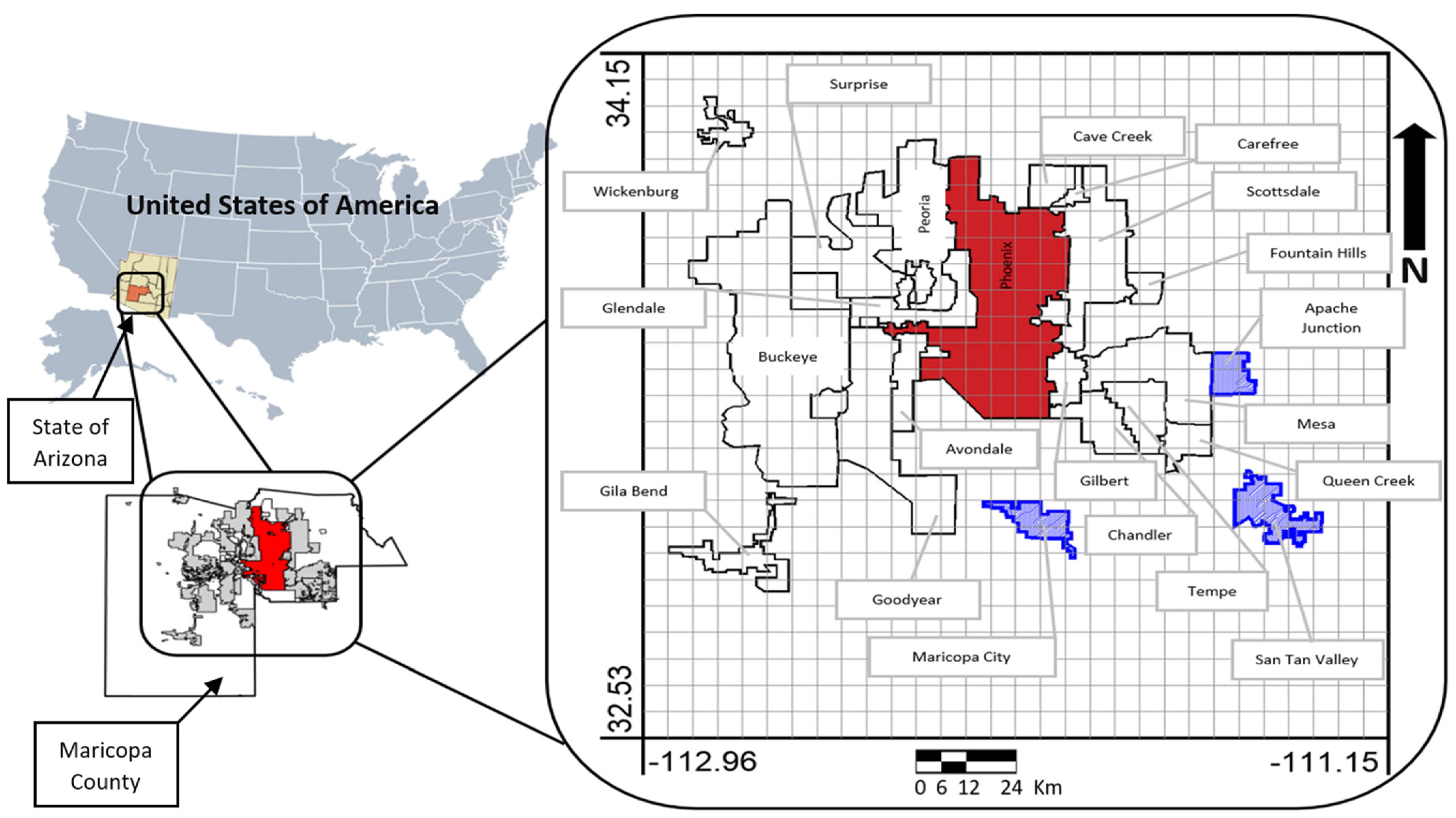
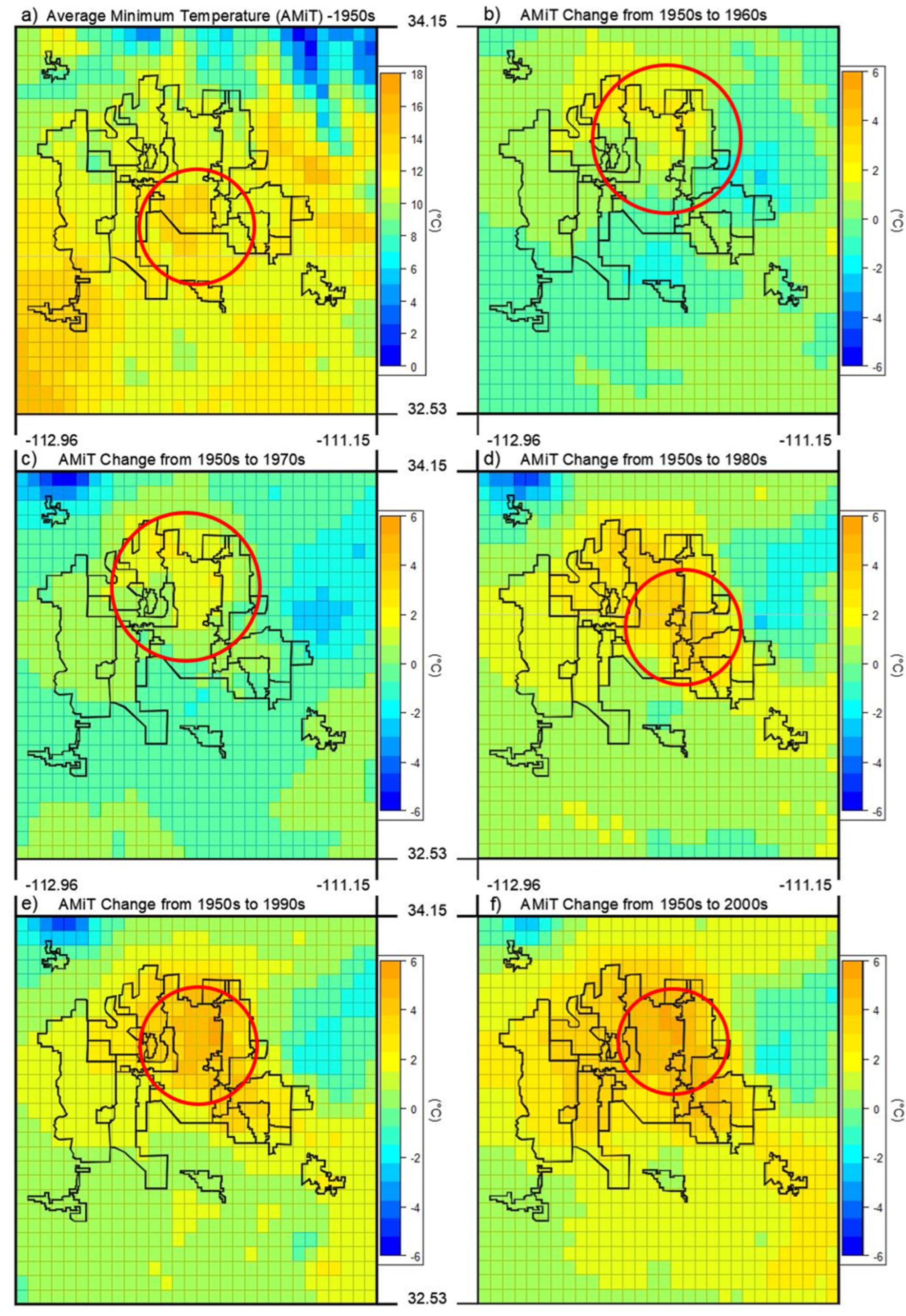
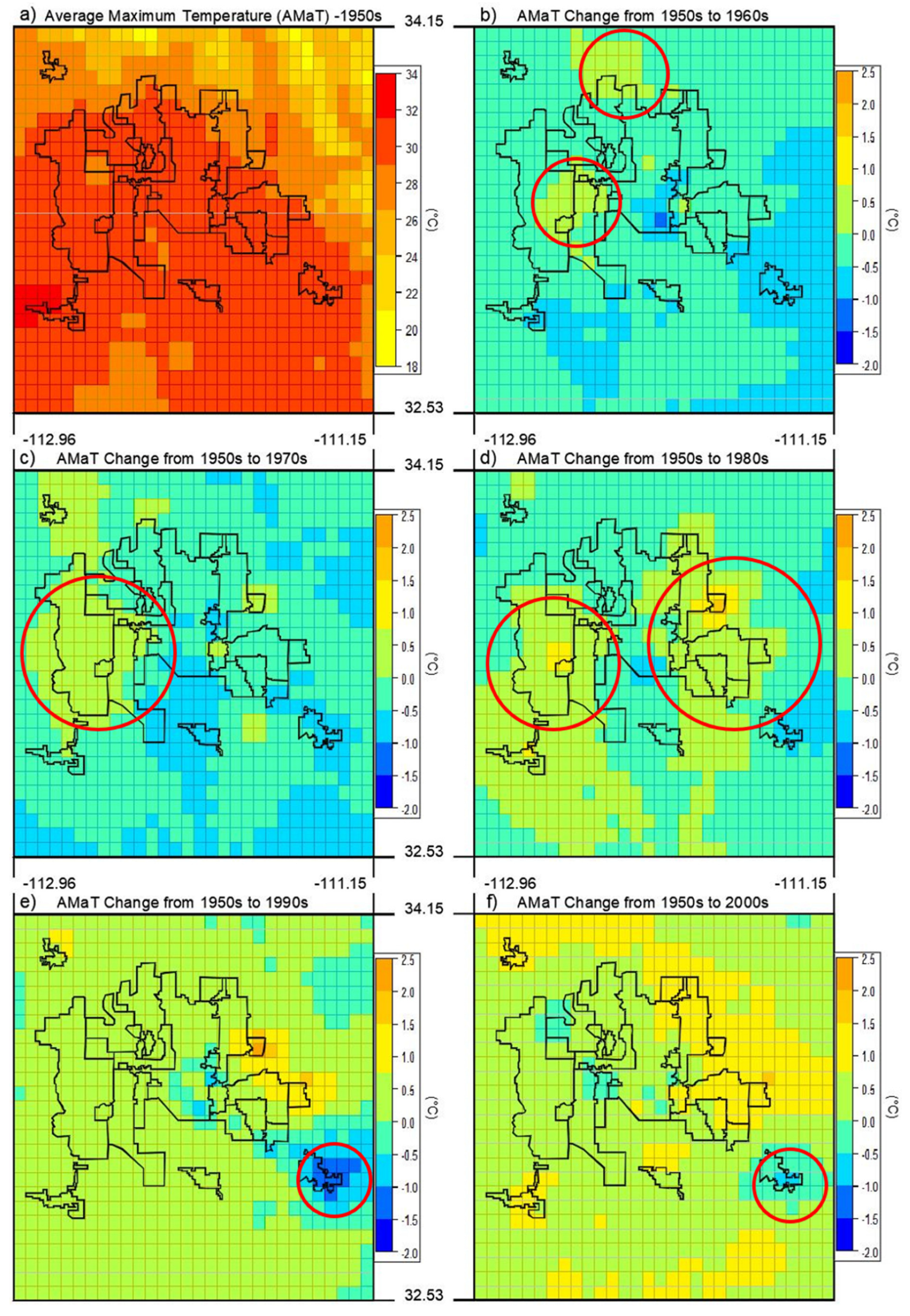
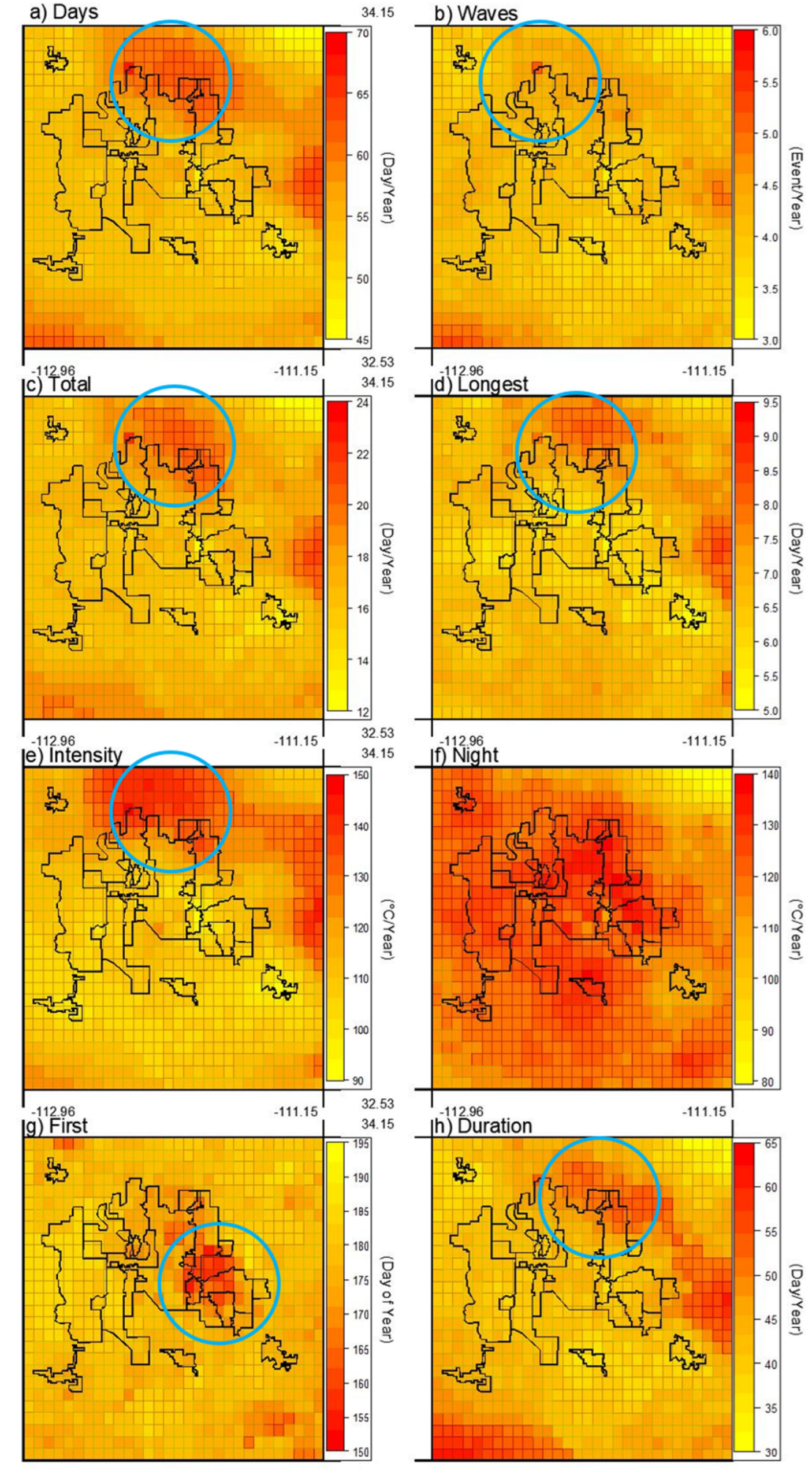
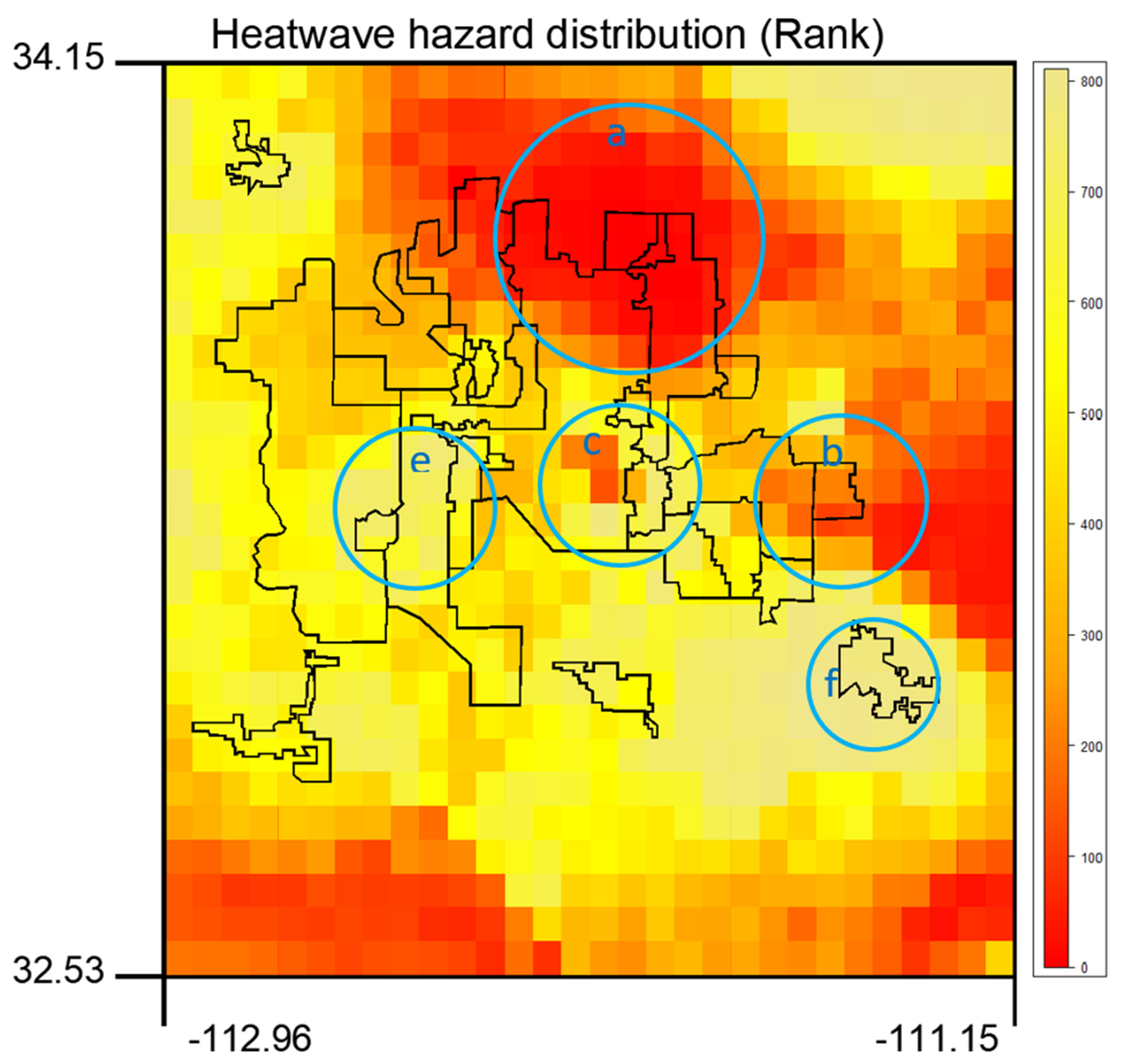
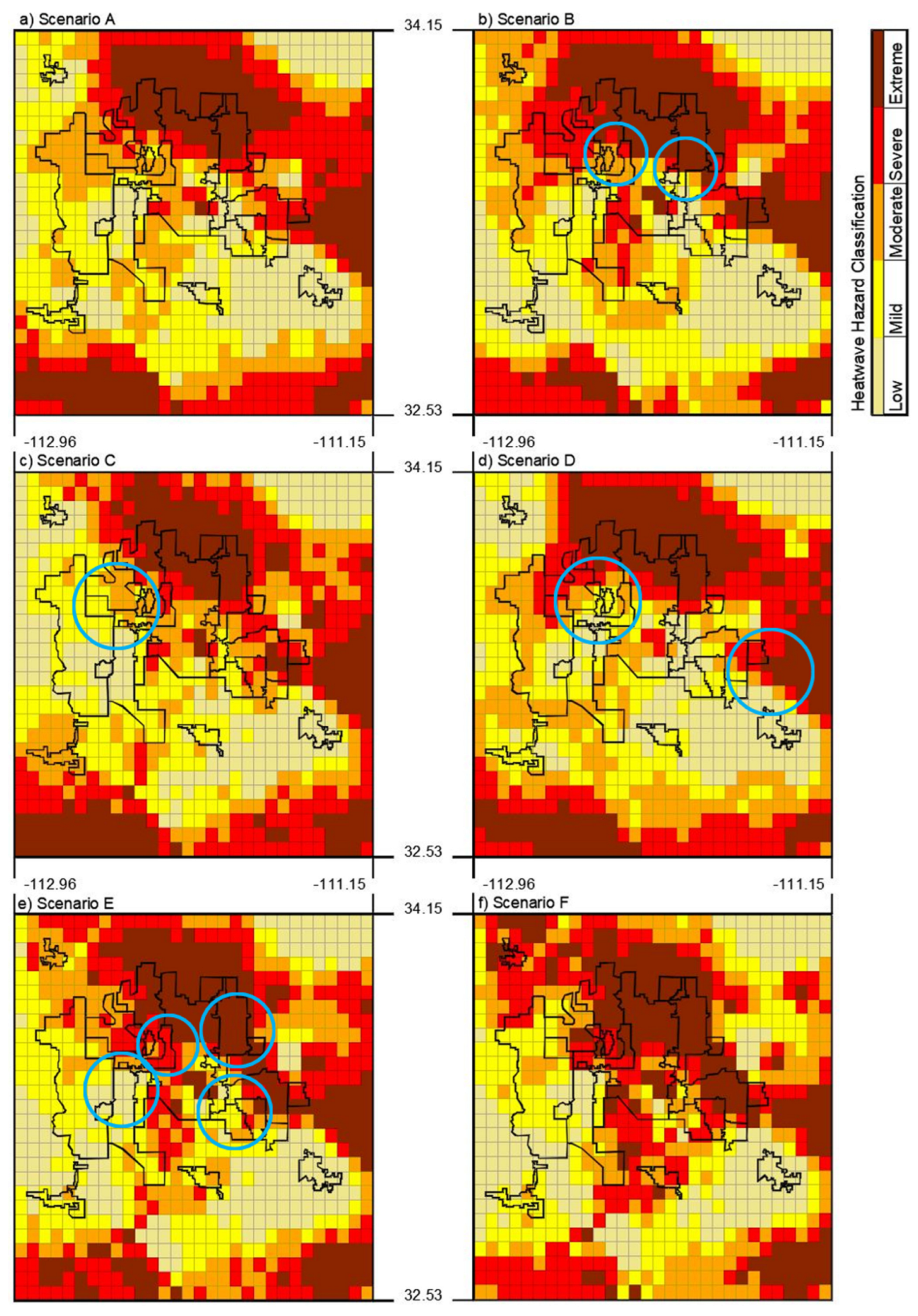
| Heat Wave Component | S1 | S2 | S3 | S4 | S5 | S6 |
|---|---|---|---|---|---|---|
| Number of hot days (Days) | 1 | 1 | 1 | 2 | 1 | 1 |
| Frequency of heat wave (Waves) | 1 | 1 | 1 | 2 | 1 | 1 |
| Total length of heat waves (Total) | 1 | 1 | 1 | 2 | 1 | 1 |
| Longest heat wave event (Longest) | 1 | 1 | 1 | 2 | 1 | 1 |
| Daytime heat wave intensity (Intensity) | 1 | 2 | 1 | 1 | 2 | 4 |
| Nighttime heat wave intensity (Night) | 1 | 2 | 1 | 1 | 2 | 4 |
| First heat wave event (First) | 1 | 1 | 2 | 1 | 2 | 4 |
| Heat wave season duration (Duration) | 1 | 1 | 2 | 1 | 1 | 1 |
Publisher’s Note: MDPI stays neutral with regard to jurisdictional claims in published maps and institutional affiliations. |
© 2022 by the authors. Licensee MDPI, Basel, Switzerland. This article is an open access article distributed under the terms and conditions of the Creative Commons Attribution (CC BY) license (https://creativecommons.org/licenses/by/4.0/).
Share and Cite
Shafiei Shiva, J.; Chandler, D.G.; Kunkel, K.E. Mapping Heat Wave Hazard in Urban Areas: A Novel Multi-Criteria Decision Making Approach. Atmosphere 2022, 13, 1037. https://doi.org/10.3390/atmos13071037
Shafiei Shiva J, Chandler DG, Kunkel KE. Mapping Heat Wave Hazard in Urban Areas: A Novel Multi-Criteria Decision Making Approach. Atmosphere. 2022; 13(7):1037. https://doi.org/10.3390/atmos13071037
Chicago/Turabian StyleShafiei Shiva, Javad, David G. Chandler, and Kenneth E. Kunkel. 2022. "Mapping Heat Wave Hazard in Urban Areas: A Novel Multi-Criteria Decision Making Approach" Atmosphere 13, no. 7: 1037. https://doi.org/10.3390/atmos13071037
APA StyleShafiei Shiva, J., Chandler, D. G., & Kunkel, K. E. (2022). Mapping Heat Wave Hazard in Urban Areas: A Novel Multi-Criteria Decision Making Approach. Atmosphere, 13(7), 1037. https://doi.org/10.3390/atmos13071037







